The Batak script, or surat Batak, is sometimes used to write the Batak languages, which are spoken in the north of Sumatra in Indonesia. Traditionally the Batak script was only used by datu (priests), and they used it to write magical texts and calendars.
Batak is thought to be a descendent of the Pallava and Old Kawi scripts, which ultimately were derived from the Brahmi script of ancient India. Or it might be a descendent of a hypothetical Proto-Sumatran script, with Pallava influences.
After Europeans - first German missionaries, then the Dutch - began visiting Batak-speaking areas from 1878 the Batak script was taught in schools, along with the Roman alphabet, and teaching and religious material was published in the script.
Not long after the First World War missionaries decided to stop using the Batak script in books. Since then the script has been used mainly for decoration purposes.
Notable features
- Type of writing system: syllabic alphabet - each consonant (aksara) has an inherent vowel. Other vowels or the absence of vowels can be indicated using diacritics which appear above, below or after the consonant letter.
- Direction of writing: traditionally written from bottom to top in vertical columns running from left to right on strips of bamboo held together with string.
Used to write:
The Batak languages of northern Sumatra - Batak Karo (Cakap Karo), Batak Dairi (Pakpak) Batak, Batak Simalungun (Sahap Simalungun), Angkola andBatak Mandailing (Saro Mandailing), and occasionally Malay.
There are slight variations in the letters and vowel diacritics used to write each language.
Karo Batak syllabic alphabet
Karo Batak is a Malayo-Polynesian language with about 600,000 spoken in the central and northern part of the Indonesian island of Sumatra.

Vowel diacritics with ka

Toba Batak syllabic alphabet
Dairi Batak, which is also known as Batak Toba, Batta or Hata Batak Toba is a Malayo-Polynesian language spoken by about 2 million people in the northern part of the Indonesian island of Sumatra.

Vowel diacritics with ka

Dairi Batak syllabic alphabet
Dairi Batak, which is also known as Dairi, Pakpak and Pakpak Dairi, is a Malayo-Polynesian language with about 1.2 million speakers in the northern part of the Indonesian island of Sumatra.

Vowel diacritics with ka

Batak Simalungun syllabic alphabet
Simalungun or Batak Simalung is a Malayo-Polynesian language spoken by about 1.2 million people in the northern part of the Indonesian island of Sumatra.

Vowel diacritics with ka

Mandaling Batak syllabic alphabet
Mandaling Batak or Batta is a Malayo-Polynesian language with about 400,000 speakers in the northern part of the Indonesian island of Sumatra.

Vowel diacritics with ka
Note
The fonts used on this page were created by Dr Uli Kozok of The University of Hawai'i at Manoa.
Sample text in Batak

Komentar
Posting Komentar